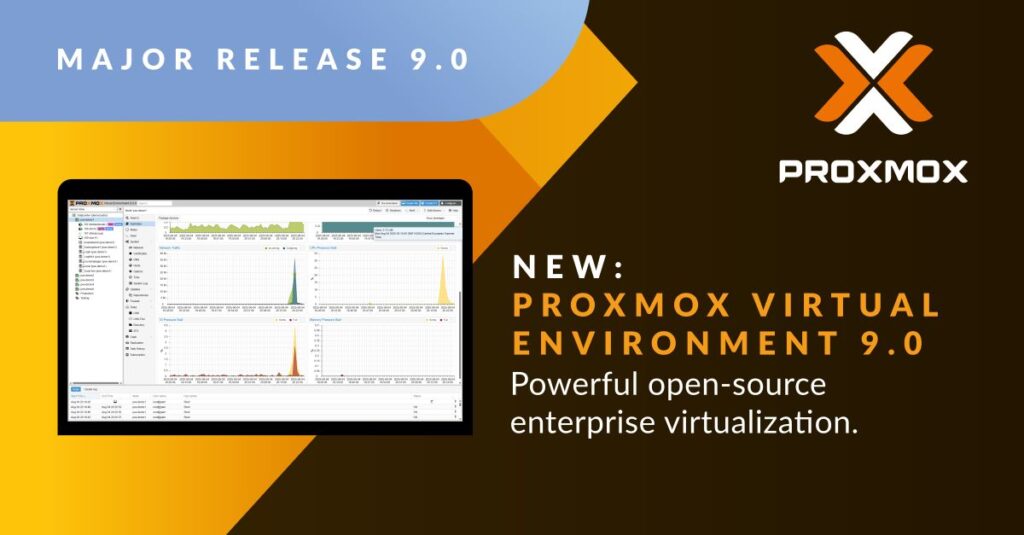July 8, 2025 marked a milestone in the virtualization and container orchestration world with the official release of Proxmox Virtual Environment 9.0, a powerful, open-source alternative to commercial virtualization platforms. This major version introduces critical enhancements across storage management, high-availability (HA), networking, and user experience, consolidating Proxmox VE as a production-ready solution for private clouds, enterprise IT, and lab environments.
Storage Snapshots, Now Vendor-Agnostic
Among the most notable features of Proxmox VE 9.0 is the new snapshot mechanism based on volume chains, which enables block-level snapshots regardless of the storage backend. This design is storage-vendor agnostic and supports platforms such as iSCSI or Fibre Channel SANs — ideal for environments requiring flexible disaster recovery and rollback strategies without being tied to proprietary solutions.
This development marks a significant evolution for Proxmox’s storage abstraction layer, empowering administrators with more consistent and predictable snapshot behavior across different hardware and protocols.
Smarter High-Availability with Affinity Rules
The 9.0 release introduces high-availability affinity rules, allowing sysadmins to define node and resource preferences more precisely. For instance, specific VMs or containers can be tied to particular nodes or kept separate from one another to minimize risk during failover events.
These rules are particularly useful in clustered environments, enabling more intelligent workload distribution and optimizing recovery strategies during node failure or maintenance windows.
Fabrics and SDN Enhancements
Networking also gets a significant upgrade through the introduction of “Fabrics” in the SDN stack. This addition makes it easier to define and manage routed network topologies across the cluster. Fabrics extend the flexibility of Proxmox’s SDN model, allowing administrators to create complex, multi-tenant networks with better routing control and isolation.
Combined with firewalling and integration with Linux bridges and Open vSwitch, these improvements turn Proxmox into a more robust option for modern networking scenarios, including hybrid cloud and edge deployments.
Built on Debian 13 “Trixie” with Modern Core Stack
Proxmox VE 9.0 is based on Debian 13 “Trixie”, whose stable release is expected on August 9, 2025, but ships with a newer Linux kernel 6.14.8-2 for enhanced hardware compatibility and performance.
Key components updated in this release include:
- QEMU 10.0.2
- LXC 6.0.4
- ZFS 2.3.3 – now supports adding new disks to RAIDZ pools online
- Ceph Squid 19.2.3 – successor to Ceph Reef
These upgrades ensure better compatibility with modern workloads, including GPU passthrough, nested virtualization, and high I/O container workloads.
Rust-Powered Mobile Web Interface
One of the more unexpected, yet welcome additions is the complete redesign of the mobile web interface, now written in Rust using the Yew framework. This move brings faster load times, enhanced security, and a more modern UI/UX — critical for on-the-go infrastructure management.
Smooth Upgrade Path from Version 8
For existing users, upgrading from Proxmox VE 8.x to 9.0 is fully supported via APT, with a detailed migration guide provided. Even users running Ceph Reef clusters can follow a two-step process to upgrade first to Ceph Squid, and then to Proxmox VE 9.0 — ensuring data continuity and minimizing disruption.
🧩 Ceph Reef to Squid Upgrade Guide
🔁 Proxmox VE 8.x to 9.0 Upgrade Guide
Why Release Before Debian 13’s Official Launch?
Some might wonder why Proxmox VE 9.0 was released ahead of Debian 13’s official stable date. According to the Proxmox team, the Debian 13 core components have been frozen since May 15, and the Proxmox-specific packages are independently maintained. Extensive testing during the beta phase and a strong developer community gave the green light for an early release.
Long-Term Support and Lifecycle
Proxmox VE 8.4 will continue receiving security updates and critical bug fixes until August 2026, giving users ample time to test and migrate to the new major version.
Additional Resources and Downloads
- 🔗 Release Notes
- 💾 Proxmox VE 9.0 Downloads
- 📘 Documentation
- 🧪 Source Code
- 💬 Community Forum
- 🐞 Bug Tracker
Final Thoughts
With version 9.0, Proxmox VE continues its evolution as a mature and reliable virtualization platform — ideal for sysadmins, SMBs, cloud providers, and researchers. The inclusion of storage vendor-agnostic snapshots, SDN fabrics, updated LXC/QEMU/ZFS stacks, and enhanced high-availability rules reinforces Proxmox’s position as a strong alternative to proprietary platforms like VMware vSphere or Microsoft Hyper-V.
The improved mobile experience and seamless upgrade path ensure that existing users can transition smoothly, while new adopters benefit from a modern, enterprise-grade stack from day one — without licensing friction or vendor lock-in.

